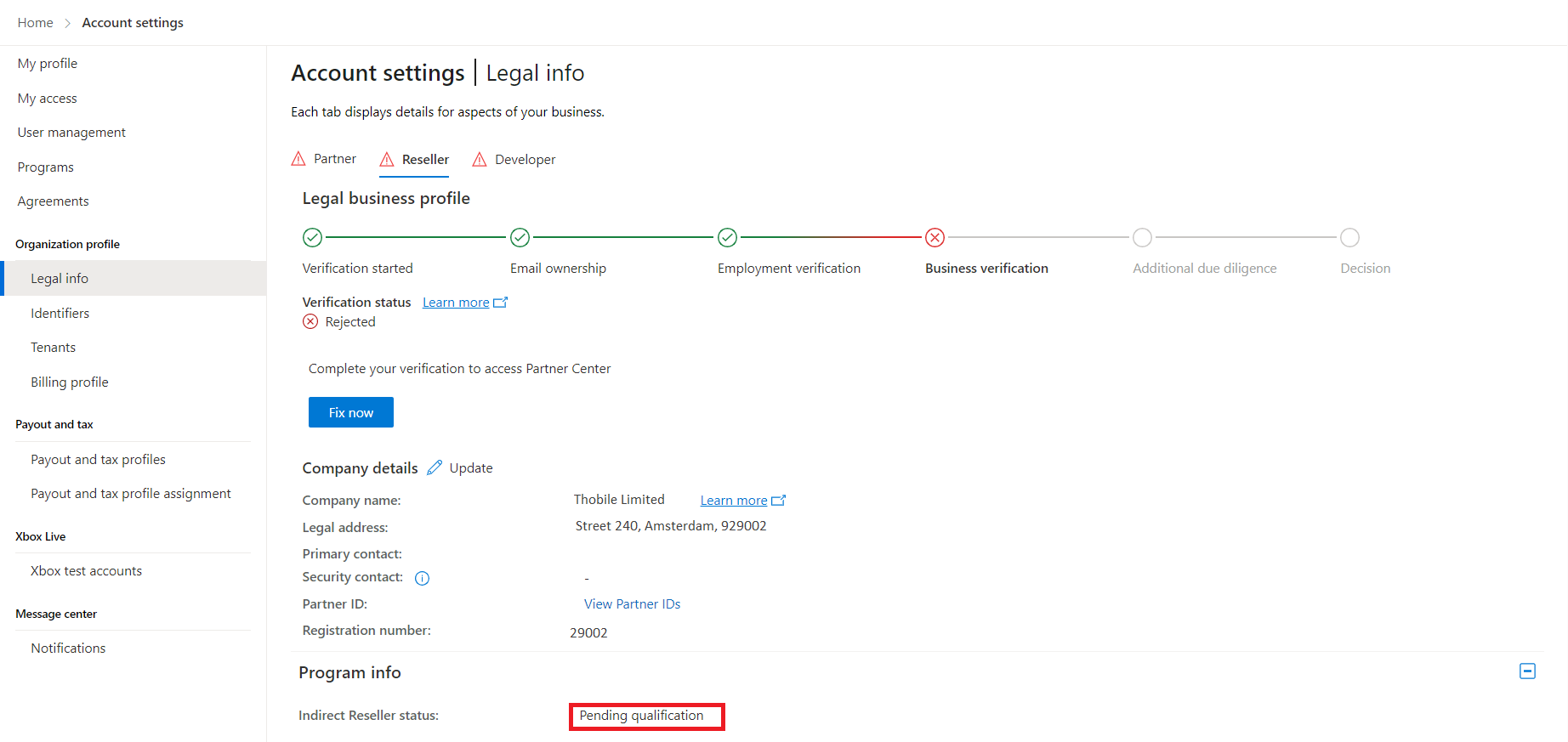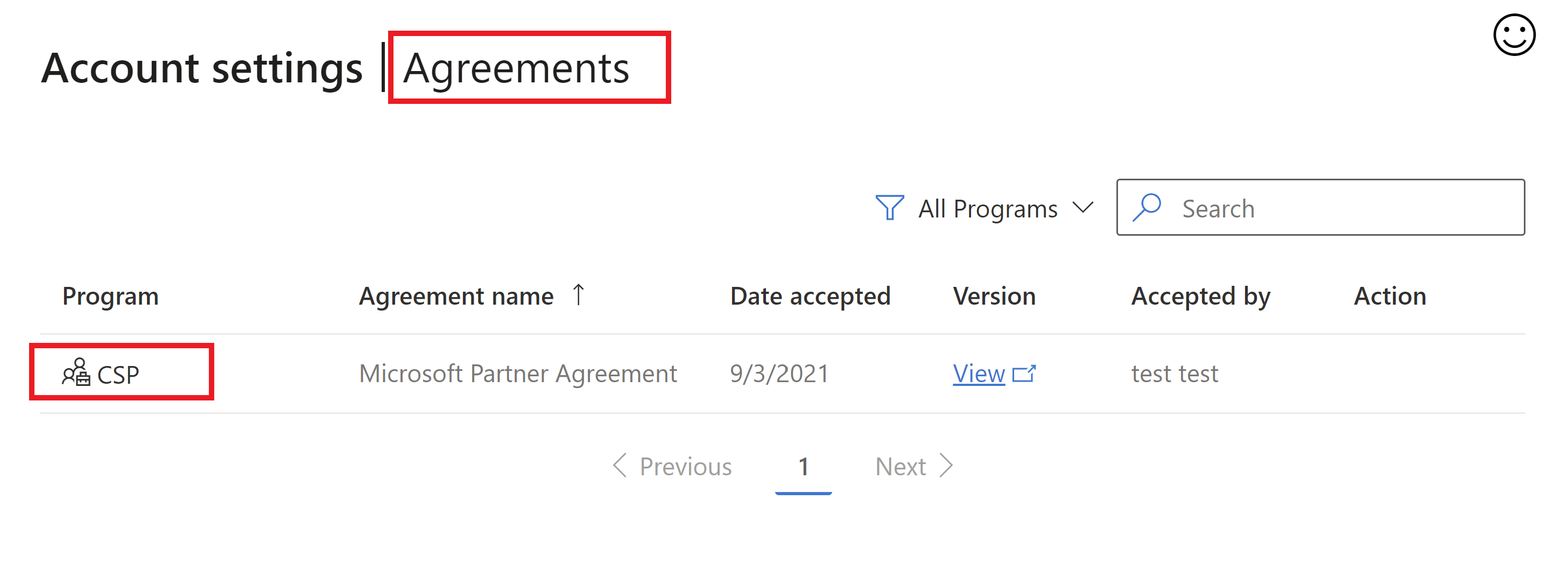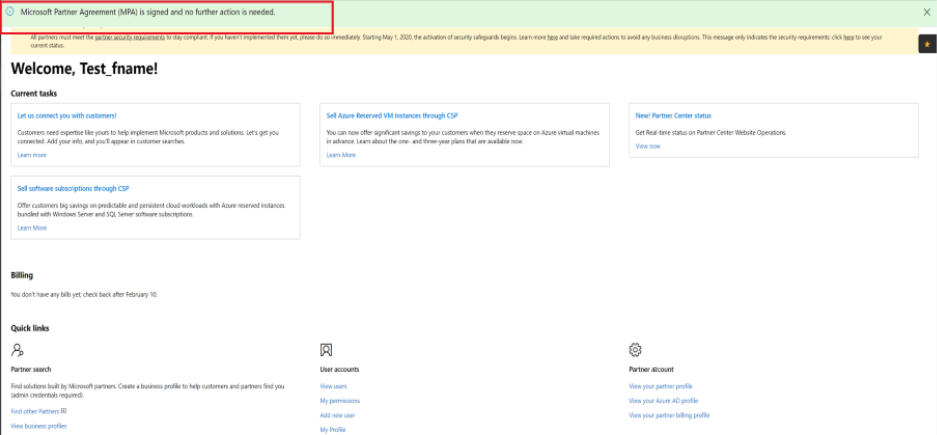Appropriate roles: Admin agent | Sales agent
The following questions and answers address potential issues and solutions for helping indirect resellers understand how and why to accept the Microsoft Partner Agreement (MPA).
Indirect providers, direct-bill partners, and indirect resellers in the Cloud Solution Provider sales authorization will find this information useful.
Questions about the MPA program and policy
What are the legal implications if an indirect reseller doesn't accept the MPA?
Unless the indirect reseller accepts the MPA, the reseller won't be authorized to transact with an indirect provider (distributor) as a Cloud Solution Provider (CSP) partner. The MPA must be accepted for each CSP tenant from which the reseller wants to transact. The assignment of a reseller partner ID to a customer subscription, without validation of reseller authorization status, is noncompliant.
Is the MPA available in local languages?
No. It's only available in English.
What should an indirect reseller do if they think they're already onboarded as a reseller because they've been transacting with an indirect provider, but they don't have the option to accept the MPA?
Authorized Indirect resellers will be able to see the CSP agreement acceptance status when they log in to Partner Center and go to the Agreements page.
If there's no CSP agreement shown, the reseller must enroll for Cloud Solution Provider authorization. The Microsoft AI Cloud Partner Program agreement is required for them to create a Partner Location Account (PLA) ID but doesn't negate the need for a CSP enrollment.
This situation also applies to "advisor" partners who have been transacting in CSP. Microsoft requires an active CSP indirect reseller tenant in each CSP region in which an indirect reseller intends to transact with indirect providers.
If a reseller works with multiple indirect providers (distributors) in various countries/regions, does the reseller need to accept the MPA in each CSP country/region?
The reseller needs to accept the MPA for every indirect reseller tenant, and associated PLA ID, that they want to activate. But they're required to have only one reseller tenant in a CSP region to be able to transact throughout the region (see this article for more on regional authorization in CSP).
Is the reseller required to keep accepting the indirect reseller MPA agreement every year?
Once the reseller accepts the MPA to activate their reseller tenant, they'll implicitly accept each annual MPA version thereafter (meaning, their continued active reseller status implies their acceptance).
If a reseller says that the MPA was already accepted by an employee who left the company, do they need to accept again?
No.
If a reseller recently changed their company name but accepted the MPA already, do they need to accept again?
Only if the reseller activated a new reseller tenant under the new name. The company name can be updated in the Partner Center CSP tenant in the partner profile section.
Is the indirect provider required to communicate with resellers about accepting the MPA, or will Microsoft work with resellers directly to accept the MPA?
It's the indirect provider's responsibility to make its channel's resellers aware of the repercussions of not accepting the MPA. The indirect provider is also required to provide them with appropriate support and guidance in accepting the MPA.
Are there any documents that describe how resellers can accept the MPA and confirm whether the latest MPA was accepted?
The following public documents can help indirect resellers accept the MPA and be compliant:
- The Microsoft Partner Agreement (MPA) for CSP - Contains step-by-step guidance to migrate Microsoft AI Cloud Partner Program account and accept MPA in Partner Center.
- Work with indirect providers in the CSP program
- Manage locations in your partner account
Questions about your Microsoft AI Cloud Partner Program and CSP account structure
What is the difference between Microsoft AI Cloud Partner Program and CSP accounts, and how are they related?
A Microsoft AI Cloud Partner Program account should be used to manage program membership. It provides one Partner Global Account (PGA) ID and one or multiple Partner Location Account (PLA) IDs, depending on the number of business locations that need to be included. A CSP account is associated with the PLA ID and is used to transact with indirect providers and manage partner incentives.
- Manage locations in your partner account
- Verify your organization profile
- Microsoft AI Cloud Partner Program membership benefits
- Manage your partner incentives
A reseller's CSP account associated with the PLA ID enables them to work with indirect providers, manage customers, and earn incentives.
What is the difference between a PGA ID and a PLA ID?
A Microsoft AI Cloud Partner Program Global Account is equivalent to the headquarters account, and Microsoft AI Cloud Partner Program locations are subsidiaries or branch locations of the parent company. There's one unique PGA ID and one or multiple unique PLA IDs in the PGA hierarchy. A partner can check the IDs by signing into Partner Center with their Microsoft AI Cloud Partner Program credentials. Select Settings > Account settings > Identifiers.
If a partner has business locations in different countries, they can create Microsoft AI Cloud Partner Program location accounts for those countries and the corresponding PLA IDs. The partner can then use those PLA IDs to enroll for new tenants, share the information with indirect providers, and get credit for incentives.
If the partner experiences issues, they should create a support request from within Partner Center.
Which Partner ID should be used for enrolling to be an indirect reseller?
Before enrolling, you should have an active Microsoft AI Cloud Partner Program Account in Partner Center. The PLA ID business address and your CSP enrollment business address should match for successful association. Sign in to your Microsoft AI Cloud Partner Program account (CSP tenant sign-in credentials might be different). Go to Settings > Account settings > Organization Profile > Identifiers and find the PLA Partner ID with Type "Location" that matches the address of your CSP tenant. Learn more about partner program locations before associating a PLA ID with your CSP tenant during the enrollment process.
How can a reseller check which PLA ID is associated with their CSP tenant?
Sign in to Partner Center tenant and select the Settings (gear) icon, then Account settings > Organization Profile > Identifiers. Under the CSP section of the page, the Associated Partner ID is the ID assigned to the reseller's CSP account and tenant.
How can a reseller view all of their Microsoft AI Cloud Partner Program Partner IDs?
Sign in to Partner Center with the Microsoft AI Cloud Partner Program account credentials (Microsoft AI Cloud Partner Program and CSP sign-in credentials might be different). Select the Settings (gear) icon, then select Account settings > Organization Profile > Identifiers to view the Partner IDs. To add a new Microsoft AI Cloud Partner Program location/subsidiary, go to the Legal profile page and select Add location.
Questions about CSP regional authorization
What is a CSP region?
A CSP region consists of one or more countries where a CSP partner located in the region is authorized to conduct business. Some examples of conducting business include working with indirect providers, transacting with customers, and accruing incentives rebates. A partner needs at least one CSP tenant associated with a legal business address in a CSP region to do business in that region.
A CSP indirect reseller must partner with an indirect provider in the same CSP region, and the reseller can sell only to customers in that region.
Why can't I associate my PLA ID with my tenant?
If you're unable to associate your PLA ID with your tenant that means that the PLA ID and the tenant aren't associated with the same business location. For the association to work, they both must be associated with the same business address. This requirement is because Microsoft incentives are paid per location and CSP partner type (indirect provider, direct bill, indirect reseller). For example, if you have a Microsoft AI Cloud Partner Program location account for France, you'll need a corresponding CSP tenant for that location to get paid CSP incentives rebates associated with that PLA ID. A PLA ID for a U.K. business location can't be associated with a location account and tenant for France.
To resolve this issue, create a Microsoft AI Cloud Partner Program location account for the same location as the CSP tenant location. To learn more, see Manage Microsoft AI Cloud Partner Program locations.
If a CSP indirect reseller has a tenant in France, can the reseller sell for an indirect provider in Germany?
Yes. Once a CSP indirect reseller tenant is active in a CSP region, the tenant can be used to do business in any country in the region. To learn more, see CSP global markets.
Can an indirect reseller in the US partner with an indirect provider in the UK?
No. CSP is a region-based authorization. The CSP tenant of both the indirect reseller and the indirect provider must be in the same CSP region. For example, a reseller can create a Microsoft AI Cloud Partner Program account in France, activate a CSP reseller tenant in France, and then accept a partnership invitation from an indirect provider in France or any of the other countries in the CSP Europe region.
Can a reseller have more than one Microsoft AI Cloud Partner Program account and CSP tenant in Partner Center?
A CSP partner typically should have only one Microsoft AI Cloud Partner Program account for their organization, but the partner can have one or many CSP tenants, depending on the partner company's business locations. For example, the reseller can have a Microsoft AI Cloud Partner Program account in the U.S. (HQ) with locations in the US, UK, and Australia. The reseller can have only one CSP tenant in US that has same domain as their Microsoft AI Cloud Partner Program account. They can have a CSP tenant in the UK on a different domain to conduct CSP business in the European region, and also one in Australia with its own domain.
All three CSP tenants above must be associated with PLA IDs corresponding to the business locations to do business and earn incentives rebates, if eligible. The Microsoft AI Cloud Partner Program Solution Partner Designations and benefits can be managed only via the Microsoft AI Cloud Partner Program account.
If a CSP indirect reseller in US wants to expand their business to Europe, what do they need to set up in Partner Center?
The reseller must have a legal business address in a European region country, and to enroll as an indirect reseller using that address. To learn more, review Prerequisites for adding a new account for a CSP business.
Questions about Microsoft AI Cloud Partner Program and CSP account verification
If a reseller enrolled in the Microsoft AI Cloud Partner Program and for a CSP indirect reseller tenant, but their legal business profile verification in Partner Center is in the "Rejected" state. What should they do?
They must update the legal profile information by selecting Fix now on the "Legal info" page in Partner Center. These articles have more information:
A reseller enrolled in the Microsoft AI Cloud Partner Program and for a CSP indirect reseller tenant, but their legal business profile verification seems to be stuck in the "Pending" state. What should they do?
If the reseller's legal business profile is in the "Pending" status for more than five business days, they should create a support request in Partner Center.
Questions about working in Partner Center
If a CSP partner doesn't know who their Partner Center admin is, who can accept the MPA?
The MPA must be accepted by a Global admin on the Azure Entra tenant that the partner has used for the CSP enrollment. To identify Global admins, select the User management link in the left nav of the Account Settings page of the tenant. In the Search box, enter global admin. Any of the Global admins listed in the search results can accept the MPA. If the partner doesn't have a Global admin, read What to do if your company needs a global admin.
If a reseller says they don't see an option to accept the MPA in Partner Center, how can their indirect provider support them?
If the reseller can sign in to Partner Center, but doesn't see the option to accept the MPA:
Do they see the Membership workspace on the home page?
If they don't see the "Membership" workspace in the Partner Center dashboard menu that means they haven't enrolled for CSP authorization. The reseller must enroll as a CSP indirect reseller as explained in Work with indirect providers in the CSP program. After they have enrolled and completed vetting, they can accept the MPA.
If they do see the "Membership" workspace, the reseller should go to Settings > Account settings > Legal > Partner OR Reseller tab and scroll down to Program Info to confirm their indirect reseller status.
If the status is anything other than Active that means that the legal business profile verification is still in progress or has been rejected. On that the same page, the reseller should check the verification status and select Learn more. The linked article helps the reseller provide the required documentation.
If a reseller needs support with passing the legal business profile check, they should open a support request with the following options:
- Select Support on the Partner Center menu, then select General > Account verification > and then choose the step that they need help with.
Only Global admins can accept the MPA. The reseller can find out what user roles are in Partner Center by following these steps:
Only Global admins can accept the MPA. To find out what your role in Partner Center is:
Sign in to Partner Center with their CSP indirect reseller account credentials and verify that their enrollment has completed vetting authorization.
Go to User management and check that the signed-in account is assigned the "Global admin" role. If it isn't, it can't be used to accept the MPA. Search for Global admin in the search box on the User management page, and request that they accept the MPA.
How can a reseller check if their company has accepted the MPA?
The reseller should sign in to Partner Center with their CSP indirect reseller credentials. If the user is an Admin agent or Sales agent in CSP, the user can go to the Agreements page to verify whether the MPA has been accepted or is available for acceptance.
If the user is a Global admin, they should go to the Agreements page. If they see a green banner, they're all set up to transact with the indirect provider in that CSP region. If not, they should select the Accept and Continue button to accept MPA and activate the CSP reseller tenant.
What if the reseller wants to accept the MPA, but can't find where (for example, a button to accept terms)?
The reseller should sign in to Partner Center with their CSP indirect reseller account credentials, and then go to the Agreements page. If they don't see the Accept and continue button and a green banner telling you that an MPA is accepted that means that the user doesn't have the right role to accept the MPA. A Global admin should then be requested to accept the MPA.




